
As I do my first load of laundry in this building (having crept vulnerably downstairs, in full view of the establishment, clutching a laundry bag), let's consider a sentence by Immanuel Kant, the first sentence of The Critique of Judgement. The first book, or section within the greater work, is called "Analytic of the Beautiful". So this is the very first thing we see when we crack open that text:
If we wish to discern whether anything is beautiful or not, we do not refer the representation of it to the Object by means of understanding with a view to cognition, but by means of the imagination (acting perhaps in conjunction with understanding) we refer the representation to the Subject and its feeling of pleasure or displeasure.
I can see why people complain about Kant. My first reaction upon reading this was to assume he meant something about the impossibilty or futility of using logic and reason to determine if a thing is beautiful, and contrasting this with the necessity of observing our emotional response ("feeling of pleasure or displeasure"). But it would be foolish to be so dismissive and reductive, so I'll struggle on through the gory details. In fact, once I'd gone through these details I was no longer sure Kant meant anything of the sort.
This part of the sentence is problematic:
...do not refer the representation of [the thing in question] to the Object...
I have a red bottlecap, and I'm trying to judge whether or not it is beautiful. The "representation" of it might mean something like its projection of electrons and the associated "object" this creates in my mind. I have an idea of this red bottlecap, which includes its image -- that's what the focus is on. So I'm not supposed to "refer" this image, this idea of the bottlecap, to the Object (the red bottle cap itself), because that won't help me judge it aesthetically.
This translation of Kant mentions "referring". I assume that it's talking about the signifier and the referrent, as is focused on in (post)modern semiotics, even though Kant predates (and I'm sure influenced) that sort of Structuralist thinking by a couple of hundred years. The referrent is the bottlecap itself, and the signifier is my idea of the bottlecap. But I'm not supposed to use the signifier-referrernt relationship on the idea of the bottlecap and the bottlecap itself, if I want to judge whether or not the bottlecap is beautiful. It won't work, according to Kant, I'm guessing because there's too much information about the bottlecap complicating the issue.
In our realm of aesthetic judgement, there can be no relationship between A. The aesthetics of the bottlecap, the image of the bottlecap, my idea of the bottlecap, and B. The bottlecap itself. "This image, this reflection of electrons, this idea of a bottlecap, refers to the bottlecap" puts ideas in our head about this object -- all sorts of associations and stories that confuse and cloud our aesthetic judgement.
But, what we can do, and must do, is take this signifier, this bottlecap-object, this representation of the bottlecap itself, and "refer" it to the Subject (in this case, me, since I'm the one staring at the red bottlecap on my desk). Does this imply that I should literally, in some sense at least, become the red bottlecap? Or is Kant (and the translator) using the word "refer" more loosely here and merely suggesting that I explore the relationship between the representation of the bottlecap and myself? That I contemplate it? See how it makes me feel?
So, I think it is this: in order to judge an object's beauty, I need to take its phenomenological mental object[1] away from it, and carve out a relationship bewteen myself and this ripped-away object, not letting the mental object refer to its parent-thing. So in essence I'm taking away a represnetation from the thing itself (I believe "thing in itself" is a Kantian term that's related to all this), and dipping my emotional toes into the representation to see what my reaction might be. If it's good, that thing is beautiful. If it's bad, it's ugly.
The properties of the actual bottlecap are not important; we take the idea of the bottlecap, and judge it independent of any prejudices we might have, or any information about the bottlecap itself. The idea of the bottlecap is a pure thing, a seperate thing, and it is that thing with which we must forge a relationship, and it is that thing upon which we must test out our.
This is of course easier said than done, which is why it might be impossible to enter a world of pure aesthetic judgement. But Kant has given us a theoretical toolkit, at least. And yes, I guess my bottlecap is beautiful.
Something called FROSH WEEK is currently going on. A "frosh" is a freshman. Urban Dictionary tells us that that the term is thought mainly to apply to new high school students, and I don't see anything restricting the domain to Canada. What's funny is turning "fresh" into "frosh" constitutes the opposite phonological gesture to "Canadian raising" -- it's "Canadian lowering" (the tongue moves down and back to make the "OH" sound, compared to the "EH" sound). Just putting two and two together. Anyway, during FROSH WEEK, all the froshes or froshies yell, carry on, and run around. I'm waiting for it to be over.
[1] Just to make sure we're clear: when we take a given thing (in this case a bottlecap), and then see it and think about it, we're creating a new object: the idea of the bottlecap.
Now that I've been here a little longer (almost two weeks), most of the subtle cultural differences I thought I was seeing between Canada and the USA have evaporated, and I've now come to see the lot as basically amounting to a pestilence of Tim Hortons, Commonwealth spellings (centre, labour, etc), and Canadian raising (the famous Canadian "ABOOT"). Supposedly one can hear Canadian raising on the "eye" dipthong as well, but "ou" jumps out at me.
A dipthong, by the way, is a vowel sound that consists of two differently-pronounced parts -- the "ou" in "about" or the "ei" in "height". If you slow those words down, you can hear "aaaaaa-b-AAAAAAHH-OOOOOOOO-t" and "hhhhhh-AAAAAAH-EEEEEEE-t".
And no, Canadians don't really say "aboot" (they get mad when you accuse them of this), but the sound moves further in that direction than the American "about"; "ABOOT" is an exaggerated phonemic approximation. In the dipthong "ou", there are two sounds: "ah" and "oo" (ab-AH-OO-t). When a Canadian pronounces this dipthong, he does something more like "ab-EH-OO-t", with his tongue a little closer to the roof of his mouth and further forward on that first part of the dipthong. There's a whole article on the phenomenon, which includes a paragraph on possible origins.
I mentioned something an entry or two ago about Canada seeming to be less of a "mean" society than the USA. This might be the only difference of any significance (ABOOT obviously isn't important or meaningful, even though it's hard for me to think about anything else for a few seconds after someone fires an ABOOT at me). I don't feel as threatened in Canada, like some beer-bellied mullet-head is going to say "WHACHOO LOOKIN AT" if my eyes wander to the wrong place for too long. It feels like a more civilized, polite society is valued and encouraged, one that doesn't foster the "belligerent redneck" (or "belligerent frat boy", or maybe just "belligerent") element that you find all over the USA.
People aren't such perpetual assholes here, who think it's cool to be tough all the time. I mentioned the culture of fear present in the USA before, and certainly fear and aggression are close bedfellows. It doesn't take much to turn a society of bowlegged swaggerers into frightened dogs in a kennel, ready to snap. And then of course the US media takes full advantage of this, and makes sure you watch the evening news segment on that latest bugbear (and buy all of the sponsored products), if you know what's good for you.
Perhaps tomorrow we'll tackle a sentence of Kant. I got the bundle of photocopies required for this semester's art theory course, and it looks damned dense indeed.
More orientation. More-ientation. Haha. Today saw another training session, this time geared for visual arts TAs. A lot of the material was a repeat of the recent 3-day seminar (even using the same examples -- there were mild complaints from the peanut gallery). Yesterday, we had a tour of the visual arts facilities, and we students introduced ourselves to each other and to our faculty mentors. My mentor wasn't there, so I have to email her and set up an informal meeting.
Thing of a professional nature: I bought my reading package for my art theory class today, and it looks extremely interesting. A purpose of my education here is to, well, complete my education -- make me less of a corn-shucking yahoo. I often feel poorly-read compared to a sort of liberal arts ideal that came into my head from somewhere, sometime along the line, somehow. Considering the theoretical bent of this art department, I think this is something that will get done.
I'm not so sure if I like this "professional blog" format -- there's a lot of diary-like ranting that I'm inclined to do, and furthermore that I'm sure would be a lot more fun to read, but also that I don't think is appropriate for a world-accessible blog. I'm might be done playing clown for the universe; it's ultimately not a good thing for the clown when he keeps hitting himself in the face with a pie.
Problem is, it's just about all I know how to do, or is at least what I've learned to do best. This "professional blog" might end up coming to an abrupt halt if I can't generate enough thoughts to fill up decently-sized entries. The only way I really know how to write is to tell the reader honestly how I'm feeling, but again I don't think that's appropriate. Quite a shame.
Perhaps I'll have more to write about once I start into my readings. Then I can tell you all about Hegel and Kant and those guys.
One thing I'll mention: it's notable how much art theory is tied to Marxism. I don't have an objection to this -- I think Marx is a crucial part of the Western intellectual tradition, and I'm happy and even eager to read him. However, it seems almost limiting that so much contemporary art theory is centered around it. For instance, what if someone wanted to base projects around ideas in music theory and zoology, totally eschewing anything postmodern or having anything to do with critical theory? Would that be legitimate? Would it be legitimate to base projects around a set of stereo instructions? Why not? Here's a quiz for you -- define the following: 1. Marxist, 2. Marixian, 3. Marxologist.
Three-day weekend starts now.
Orientations don't re-commence until tomorrow; today I'm going to explore the Fitness Centre and maybe see a movie at the discount theater on campus. Then another "orientation" (this time a TA workshop -- I guess it will be different in some way than the TA training). Then a weekend. Then Labour Day. Then International TA Day, then I suppose a regular old TA day, then a day off, then my first class. And at that point, the schoolyear will have begun in earnest.
I don't know how to differ between a seminar, orientation, workshop, and training. I think it's all basically the same thing: pre-exposure to concepts and structures. Anyway, I have a lot of it. Especially weird is that there are three different instances of TA orientation -- I wonder if there will be some overlap. Probably. I'm not 100% sure I want to go to International TA day; I'm not technically an international student, and I might rather unpack or do other things. I think they'll be covering subjects like tolerance and diversity in the Canadian classroom.
I installed my television, which may have been a mistake: although I slept for 9 hours last night, today, after the last installment of my three-day TA-training seminar, I fell asleep to some sitcoms on Canadian cable television at around 7pm, and had one of those particularly deadly evening naps until midnight. Now, it's very questionable whether or not I'll get to sleep before 4am or so, although I will try.
Tomorrow, Bell Canada are supposed to show up between 8am and 12pm and end my almost week-long period of phonelessness. After that, I think I might have a couple of days largely "off" (excepting a possible mission to a local shopping mall to purchase some stuff like a dish rack, iron, roller chair pad, etc) until I have to resume professional activity with another lengthy orientation of some kind (either visual arts, general graduate, or international graduate).
The teacher training seminar was sort of harsh -- a 3-day meeting, essentially, held over the course of the weekend. At least we got free lunch and granola bars, and perhaps most importantly, coffee. But I'm glad I went. Probably the most valuable thing about it was the contacts I acquired. Networking truly is the name of the game, whether you like it or not. We humans are gregarious creatures.
After so many years of living alone and stomping outside to yell at this or that neighbor for making noise, I now must learn to accept the constant buzz of ambient humanity, including the occasional crash, holler, or whoop. That said, my first night I did knock on my neighbor's door at 12am after trying to sleep through about 30 minutes of her pounding nails into the wall. If she had answered, I would have asked her to please wait until morning to do this, but she didn't. However, the pounding thereafter stopped.
The fact of the matter is that people are just NOISY. They like to crash around and exercise their vocal chords. Many of them actually enjoy making noise. And I live in a compressed community of 25,000 of them. Fighting the good fight is a losing battle; I'll have to rely instead on my new-found Canadian tolerance, now a full five days in the making.
Differences between English Canada and the USA? It seems like there's more intolerance, hatred, and fear in the USA. Canada is like a less "mean" version of the United States -- one less likely to fire a six-gun at your toes and yell "Dance!" at you. And no, they don't say "ABOOT". But the vowel sound in house, about, shout, etc, does sound a little different. But certainly there's less difference between Great Lakes Ontario Canadian English and Upper Great Lakes American English than there is between Upper Great Lakes American English and Texas English. I think I feel a bit more comfortable here, but that could be for reasons other than "moving to Canada". Further study is needed.
As today's blog I thought I'd post the slides from a Powerpoint presentation I've prepared for a 10-minute "microteaching" session, which I'm going to give today. It's part of the 3-day seminar on teaching assistant training in which I'm enrolled (Friday, Saturday, Sunday). There are TAs from all across the University in attendance. I'm the only one from Visual Arts; most seem to be from the sciences. It was suggested that we pick something "from our field" to microteach, so I decided to do a very quick (hopefully under 10 minutes, knock on wood), easy intro to art theory. The Powerpoint slides have been exported as images and the corresponding lecture notes posted under each slide image. Here goes:

Today I'm going to ask you an unanswerable question. WHAT IS ART?
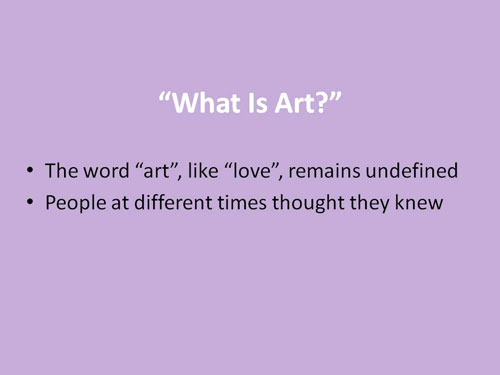
It turns out that this is not an easy question to answer. The word "art" itself is problematic -- in fact, it might not be definable, at least in this contemporary age. However, if you look back, people didn't use to think this was a hard question; the answer used to seem pretty obvious.
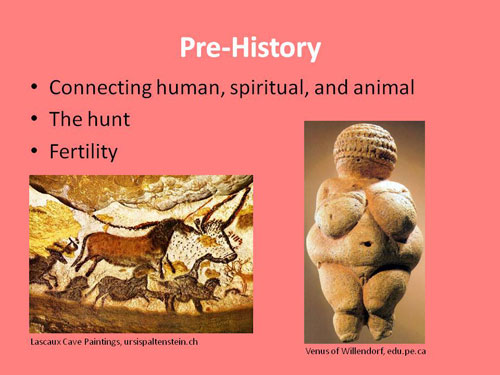
In pre-historic times, art had a PURPOSE: it connected the things that were important to ancient peoples: themselves, the animals they hunted, making babies: very basic survival stuff. Scholars think "cave people" drew pictures of the hunt, or sculpted fertility figures, as a magical way to make these depictions come true.
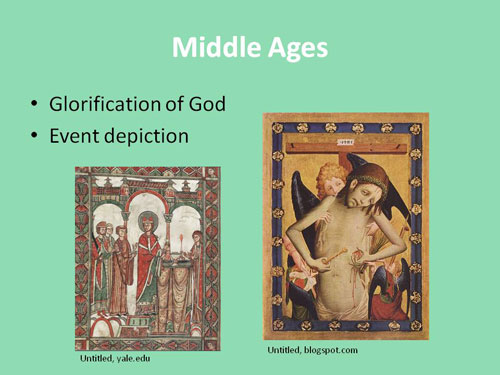
Jump ahead to the middle ages. In a sense, the art of this period had not progressed much beyond the cave paintings at lascaux or the venus of willendorf. Conceptually, they're still focused on very low-level stuff -- in this case religion (ie, magic) or just portraying everyday life. It's important to note that these two images
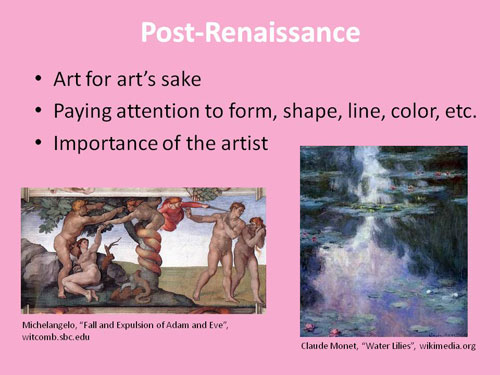
Around the early 1400s, there was an important shift in the way we thought about what we were drawing and sculpting. People started thinking about not just the subject matter, but things like "ok, this line might look better if I drew it like this" or "the background might look more like a background if I obscurred and blurred it out a little bit" -- they started thinking about the process of art-creation itself. Art as a discipline had been created, and from there it could progress. Just as importantly, the notion of the creator of a piece emerged as an important bit of information to have; people started signing their work.
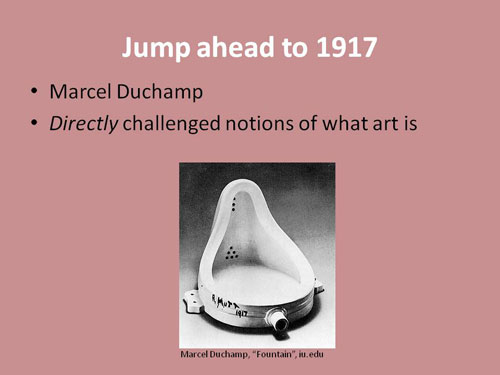
Now, we're going to jump ahead several hundred years to the year 1917 in france, when a man named marcel duchamp signed a urinal and put it in a gallery. Suddenly, people who were used to art being a very serious thing were staring at this urinal and wondering if there was something they were missing. "why, this must be art! It's in a gallery, and was put there by a professional artist!" art could not, and would not, ever be the same, because duchamp had demonstrated that context and concept were what made art, rather than some innate material qualities. If I call it art, it's art. If you perceive it as art, it's art. So, there's one possible answer to our unanswerable question, and it's an answer that a lot of people today don't like. They'll say things like "but if art can be anything, then the word 'art' becomes useless and meaningless. Why not throw it out?" they might very well be correct.
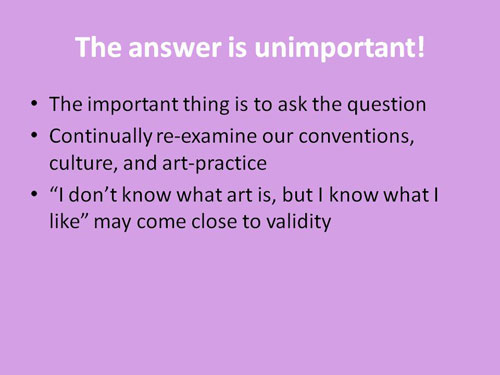
Although our question might be unanswerable, I also think it's important to keep asking it anyway, and keep thinking about why we think something is ART, and what the word ART means to us. The only thing that really matters is that you're getting some pleasure or sustenance from what you create or consume. In that sense, the old layman's quote "i don't know what art is, but I know what I like" is dead-on.
I think blogging in the morning makes the most sense. I like to go to bed around 11pm and wake up at 7am, and nothing is open until around nine. So, this gives me some time to eat, blog, etc. I did a huge number of errands yesterday, including biking downtown to the Ontario Health Insurance Plan (OHIP) office (to procure the fabled ~*CANADIAN HEALTHCARE*~).
Canadian healthcare, of course, isn't as simple or wonderful as many people might imagine. I had fantasized that one could present a passport, or possibly "social insurance card" (still not quite sure what the purpose of this card is), and any hospital or service provider in Canada would say "lol, come on in!" In fact, healthcare is adminstrated by the provinces (in this case, Ontario), and requires a special photo ID card. You have to prove residence and citizenship, and then it comes in the mail 3 months later.
But the most interesting thing is that prescription medication and a few other services are NOT covered (as far as I understand it) by OHIP. To fill this vacuum, the Canadian free market has sprung up and offered service-specific policies like drug plans, that you can buy for I-don't-know-how-much. In my case, prescription drugs will be covered by the Society of Graduate Students (SOGS). Furthermore, in these three months before my OHIP kicks in, my general medical care will be covered under mandatory UHIP (University Health Insurance Plan), which mirrors the coverage of OHIP and will cost me $60 CAD a month.
I met the prof I'll be teaching with for the first time last night. He gave me some course materials, bought me a Labbat Bleu (a Canadian beer my Dad used to drink when I lived in Canada as a child), and told me a little bit about stuff to come, even though it was a bit hard to hear him, since we were in "The Grad Club", and there was live music playing.
It seems that my role will fundamentally be one of wandering around the classroom engaging students, grading tests, and being sort of a "gofer" for needed classroom items -- a teaching assistant. Thass me. The class is an "Introduction to Art Practice Class", intended for non-majors. We go through several different units, including video, pinhole camera, drawing, printmaking, etc, and the students are expected to produce projects in these various media. The students are also expected to read art theory texts and discuss them in class. I am to lead two of the units later on in the semester; sort of a role-reversal for the prof and me, which gives him a break and gives me more experience.
I think the essence of my fantasy about Canadian healthcare was that it was somehow part of a Star Trek utopia, not tied in to the money economy. This is not the case -- it's very much based on money, its exchange and transfer, and all the associated documentation and tedium. It's just that the source of this money is federal funding (I think -- I'll get back to you. It might be partly provincial funding. I don't know how all this stuff works, really). And, ultimately, as the Libertarians and free-market enthusiasts will trumpet, THE TAXPAYER. I suppose this is what happens when THE TAXPAYER isn't paying for 3 trillion dollar invasions all over the globe: he has some money to allocate elsewhere.
I enjoy getting little brainless administrative things done. Things like looking at my new wallet, which is now filled with Canadian cards, and my new keychain, which is now filled with Canadian keys, give me pleasure. I do have something of a meticulous nature, underneath the failure to shave and bowls of chicken bones lying around the apartment.
Two things contributing to the difficulty of writing this first entry: 1. I have not blogged in a really long time and have consequently atrophied blogging muscles. 2. I'm in a new place -- my new place -- and my mind is a bit otherwise occupied with moving in. But I think now, here, on my 3rd day in London at 7:18 AM, sitting at my familiar desk with my familiar laptop, I can eke out an entry.
When I first thought of resuming blogging at school, I decided that I wanted it to be in a more professional capacity. For one thing, the reader will note that I'm using proper capitalization. But more importantly, this infers that I won't be whining about how I hate life, the universe, pop-tarts, and everything, but only talking about "what I do" (which is attend an MFA program in visual arts at the University of Western Ontario, and produce associated projects).
I'll have to do a lot of writing for this program, including a 50 page thesis towards the end. Considering the amount of "hobby writing" I've generated over the past 7 years, I don't think these 50 pages or any other pages should be an insurmountable issue. But for now, I'm certainly feeling a little rusty, and it would be helpful to oil the mental machinery of the writing process before I have to start producing text for grading and other official scrutiny.
I'm moved in -- everything has been unloaded from my uHaul (is that the capitalization convention for uHaul? Like iPod?), and said uHaul has been returned to a seedy rental location near downtown London. I biked back, my first bike ride. I think it's about 6 km from the uHaul place to my apartment, and then I tacked on another 2 km riding to my new grocery store ("Loblaw's") to get my first batch of groceries. Loblaw's is nice -- very gourmet, new, well-designed, fancy, super-clean. If I had moved in the opposite direction (London, ON to Gaithersburg, MD) and was forced to switch from Loblaws to the Giant on Bureau Drive, I would be pretty traumatized.
In terms of professional activities, I shall lazily slip into a few of those today, or at least minor administrative duties related to future professional activities (reserve a spot at a TA training seminar, pick up my new VISA card, get my student ID, set up direct deposit, and meet this evening with the professor with whom I'll be teaching a class).
I have some ideas for art projects -- a document called ideas.txt that I've been adding to all spring and summer (created when I accepted UWO's offer of admission). Every once and a while an inspiration will hit me, and I'll write it down. My plan now is to map all of these ideas out on a big sheet of posterboard, and draw lines between them.
So, let's say we have ideas about fish, human anatomy, and the sociology of the armed forces. That could yield fish anatomy, or social behavior in fish, or weapon design based on human anatomy, or some kind of sci-fi biotechnology whargarble based on all three. Basically I'm hoping that using a visual pattern on textual ideas will yield some interesting results. As far as media goes, right now I'm thinking "Adobe Director" and CD-ROMs. That's a little less cheesy than web-based work, I think, and enables me to do something cool and materials-y with the packaging. I'm not so interested in performance, at least not until I lose a lot more weight (haha).
I'll be registered for two classes: a studio practice class, and a theory class. I was told that the theory class was going to use (among other things) Kant and Hegel as conceptual meat. These two writers are part of an intellectual progression that leads to Marx (or so I'm told), and I did see at least one graduate student who was basing projects on ideas of a more contemporary Marxist thinker.
I gotta go do stuff.